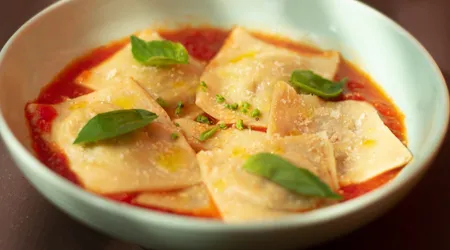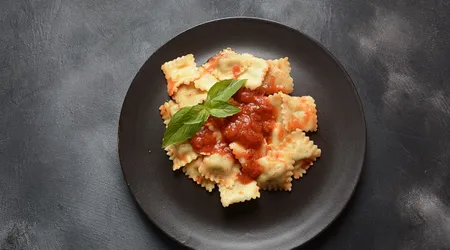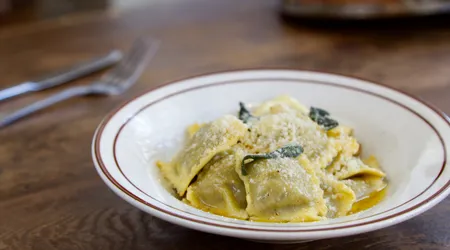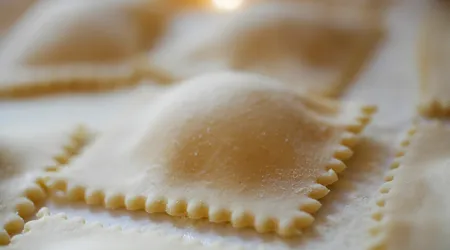How to make homemade stuffed ravioli

Prepare homemade stuffed ravioli It is much more than a simple culinary act: it is a ritual that intertwines history, creativity and passion.
Announcements
In a world dominated by prepackaged foods, rediscovering the art of kneading, filling, and sealing ravioli represents a return to our roots, a way to celebrate cooking as an expression of love and care.
But what makes homemade ravioli so special?
Maybe it's the satisfaction of transforming simple ingredients into a dish that tells a story, or maybe it's the unmistakable taste of fresh pasta that melts in your mouth.
In this article, we'll explore how to make homemade stuffed ravioli, with techniques, tips, and inspiration to make every bite a unique experience.
Announcements
The magic of fresh pasta: the heart of homemade stuffed ravioli

The foundation of every perfect ravioli is fresh pasta, an element that requires precision but also a pinch of intuition.
Contrary to popular belief, making pasta isn't an art reserved for star chefs. With type "00" flour and fresh eggs, you can create an elastic and velvety dough.
The classic ratio is 100g of flour for every egg, but the real secret lies in the kneading: kneading for at least 10 minutes develops the gluten, ensuring a consistency that holds its shape well during cooking.
Furthermore, letting the dough rest for 30 minutes, wrapped in cling film, allows the dough to relax, making it easier to roll out.
However, it is not enough to follow a recipe to the letter.
++ Calabrese Baked Pasta: A Family Recipe
The quality of the ingredients is crucial: organic eggs, for example, give a golden color and a richer flavor.
Additionally, ambient humidity can affect the dough, so it's helpful to learn to "feel" the dough, adding a spoonful of water or a pinch of flour if necessary.
This seemingly simple process is a dialogue between you and the ingredients, a balance that is refined with practice.
Isn't this the charm of artisanal cuisine, where every gesture becomes part of the final result?
For beginners, a pasta machine can be a valuable ally, but a rolling pin and a well-floured work surface can also work wonders.
++ Ricotta and Spinach Cannelloni: How to Make Them
The goal is to obtain a thin, almost transparent sheet of pastry that allows the filling to be seen without breaking.
This step, often overlooked, is what distinguishes a mediocre ravioli from an extraordinary one.
With a well-calibrated pastry, the filling becomes the protagonist, wrapped in a pasta embrace that enhances its flavor.
Information table
| Ingredients for fresh pasta (4 people) | Amount | Notes |
|---|---|---|
| “00” flour | 400 g | Preferably low in gluten |
| Medium eggs | 4 | Organic for a more intense color |
| Salt | 1 pinch | Optional, to enhance the flavor |
| Waterfall | to taste | Only if the dough is too dry |
The perfect filling: creativity and tradition in balance

The filling of homemade stuffed ravioli is the heart of the dish, a chance to express your personality in the kitchen.
Italian tradition offers endless variations: from the classic ricotta and spinach filling, typical of Emilia-Romagna, to the sophisticated pumpkin and amaretti filling of Lombardy.
However, what makes a filling memorable is the balance of flavors and textures.
For example, a filling that is too moist risks sopping the pasta, while one that is too dry can be heavy.
The key? Fresh ingredients and meticulous preparation.
Let's take an original example: ravioli stuffed with purple potatoes, gorgonzola and walnuts.
Antioxidant-rich purple potatoes lend vibrant color and natural sweetness. Gorgonzola adds a creamy, tangy note, while chopped walnuts add crunch.
To prepare it, mash 300 g of boiled purple potatoes, mix with 100 g of sweet gorgonzola and 30 g of finely chopped walnuts.
Season with salt, pepper and a pinch of nutmeg.
This filling, modern yet rooted in Italian dairy tradition, is an example of how you can innovate without losing authenticity.
Another creative idea is the stuffed with smoked fish and lemon, perfect for a special occasion.
Mix 200g of chopped smoked salmon with 100g of ricotta, the zest of an organic lemon and a tablespoon of fresh dill.
This light and aromatic filling pairs beautifully with a butter and sage dressing.
The freshness of the lemon balances the richness of the salmon, creating a contrast that surprises the palate.
Isn't that the beauty of cooking? Finding harmony in unexpected combinations?
| Examples of original fillings | Main ingredients | Recommended seasoning |
|---|---|---|
| Purple potatoes, gorgonzola, walnuts | Purple potatoes, sweet gorgonzola, walnuts | Melted butter with sage |
| Smoked salmon and lemon | Smoked salmon, ricotta, lemon zest, dill | Extra virgin olive oil and black pepper |
Assembly techniques: precision and patience for perfect ravioli
Assembling homemade stuffed ravioli is an art that requires care and attention to detail.
Once the pastry has been rolled out, the first step is to decide on the shape: square, round or crescent?
Each choice influences the aesthetics and distribution of the filling.
For beginners, square ravioli are the simplest: roll out a strip of dough, arrange small portions of filling at regular intervals, cover with another sheet of dough, and press around the filling to seal.
Use a toothed pastry wheel to cut the ravioli, making sure the edges are tightly sealed to prevent them from leaking during cooking.
++ Potato Gnocchi: Basic Recipe and Variations
A common mistake is overloading the ravioli with filling, which can cause them to explode during cooking.
An amount of about one teaspoon per ravioli is sufficient for a standard-sized sheet of pasta (5x5 cm).
Additionally, lightly moistening the edges with water or egg white helps create an airtight seal.
This seemingly trivial step is like sealing a precious letter: a small gesture that protects the content and guarantees success.
Finally, cooking is the moment of truth. Fresh ravioli cook in 2-4 minutes in boiling salted water, but the exact time depends on the thickness of the pasta.
To be on the safe side, try a test ravioli.
An interesting statistic?
According to a survey conducted by the Italian Academy of Cuisine in 2023, 68% of Italians prefer homemade ravioli to store-bought ones, precisely because of their unique texture and authentic flavor.
It's no surprise: a handmade ravioli is like a hand-painted painting, unique and unrepeatable.
| Common assembly mistakes | Solution |
|---|---|
| Excessive stuffing | Use a teaspoon to measure |
| Poorly sealed edges | Moisten with water or egg white |
| The pastry is too thick | Roll out to 1-2mm thick |
Seasonings and presentations: the art of enhancing ravioli

A homemade stuffed ravioli is like a blank canvas: the seasoning is the color that enhances its beauty.
The choice of seasoning must respect the filling, without overpowering it.
For example, a delicate filling like ricotta and spinach pairs perfectly with a classic butter and sage sauce, which allows the flavors to emerge without overpowering them.
Conversely, a robust filling like braised meat calls for a rich tomato sauce or red wine reduction to create a bold contrast.
Presentation is equally important. Imagine serving your ravioli on a white plate, sprinkled with parmesan cheese and a fresh basil leaf: it's not just food, it's a visual experience.
An original idea is to garnish with microgreens or edible flowers, which add a touch of elegance and freshness.
Also, consider the temperature: ravioli should be served warm, but not piping hot, to fully appreciate the complexity of their flavors.
Finally, don't underestimate the power of a good wine to complement a dish.
A pumpkin-filled ravioli, for example, pairs beautifully with a crisp Vermentino, while a meat-filled one calls for a full-bodied Chianti.
This attention to detail transforms a simple meal into a moment of conviviality.
Isn't this the true meaning of Italian cuisine, where every dish is an opportunity to share joy?
| Condiments by type of filling | Stuffed | Ideal seasoning |
|---|---|---|
| Ricotta and spinach | Delicate | Butter and sage |
| Braised meat | Robust | Tomato sauce |
| Pumpkin and amaretti biscuits | Sweet | Melted butter with cinnamon |
Frequent questions about homemade stuffed ravioli
| Request | Answer |
|---|---|
| Can I make the ravioli ahead of time? | Yes, you can freeze them on a floured tray and then transfer them to freezer bags. Cook them directly from frozen, adding 1-2 minutes to the cooking time. |
| How to prevent ravioli from sticking together? | Flour your work surface well and use durum wheat semolina to dust the finished ravioli. Keep them separate until ready to cook. |
| Can I use whole wheat flour? | Sure, but the pasta will be more rustic and may require more liquid. Mix whole wheat flour and "00" flour for a good compromise. |
| How long does fresh pasta keep? | Wrapped in plastic wrap, it will keep in the refrigerator for 1-2 days. For longer periods, freeze it. |
Homemade Stuffed Ravioli: Conclusion
Prepare homemade stuffed ravioli It's like composing a symphony: every ingredient, every gesture, every choice contributes to the final harmony.
From fresh pasta to filling, from assembly to presentation, this process is a journey that celebrates creativity and tradition.
With a little practice and the right tricks, anyone can transform a handful of flour and an idea into a heart-warming dish.
So, what are you waiting for?
Grab a rolling pin, choose your filling, and start creating your culinary masterpiece. Isn't this the magic of cooking, capable of transforming the ordinary into the extraordinary?
